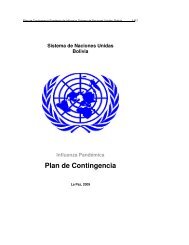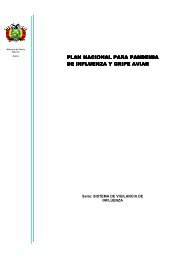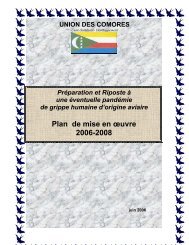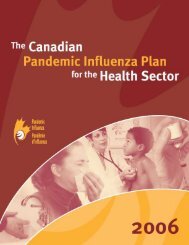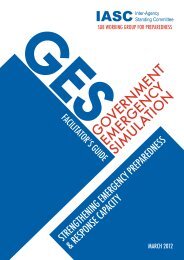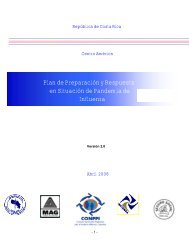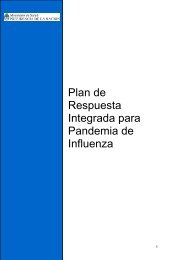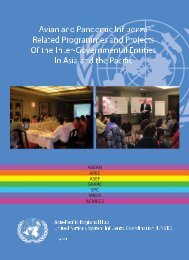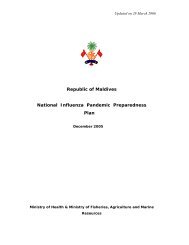Tanzania National Plan (January 2007)[1].pdf - Avian Influenza and ...
Tanzania National Plan (January 2007)[1].pdf - Avian Influenza and ...
Tanzania National Plan (January 2007)[1].pdf - Avian Influenza and ...
Create successful ePaper yourself
Turn your PDF publications into a flip-book with our unique Google optimized e-Paper software.
<strong>Tanzania</strong> <strong>Avian</strong> <strong>Influenza</strong> <strong>National</strong> Emergency Preparedness & Response <strong>Plan</strong><br />
2.1 Background information<br />
2.0 BACKGROUND<br />
This <strong>National</strong> <strong>Avian</strong> <strong>Influenza</strong> Emergency Preparedness <strong>and</strong> Response <strong>Plan</strong> has been<br />
designed to give direction to <strong>Tanzania</strong>’s efforts to strengthen emergency<br />
preparedness against the eventuality of <strong>Avian</strong> <strong>Influenza</strong> being introduced into this<br />
currently presumed free area. There is growing evidence that the fatal avian influenza<br />
type H5N1 which has been responsible for serious disease outbreaks in poultry <strong>and</strong><br />
humans in several Asian countries since 2003 has arrived <strong>and</strong> is bound to spread to<br />
many parts of Africa. Laboratory tests of the virus responsible for the recently reported<br />
outbreaks in Nigeria indicate that the causative virus is similar to those found in<br />
Turkey <strong>and</strong> the ones found in Asian countries.<br />
The disease is spread through a number of sources that include movement of<br />
domestic or wild birds <strong>and</strong> bird products through legal or illegal trade, travelers<br />
returning from affected countries in Asia, Middle East or other African Countries, <strong>and</strong>,<br />
although unproven, it is suspected that the virus could possibly be carried over long<br />
distances along the migratory bird flyways to regions previously unaffected. <strong>Tanzania</strong><br />
may get the disease from any of the above means of transmission.<br />
What is more worrying is that <strong>Tanzania</strong>’s poultry farming systems are open, free<br />
range, systems with poor biosecurity <strong>and</strong> with lots of mixing between wild animals,<br />
domestic animals <strong>and</strong> human beings. Moreover, poultry marketing <strong>and</strong> subsequent<br />
slaughtering in <strong>Tanzania</strong> is carried out in a manner that can be conducive to rapid<br />
spread of infectious viruses. Therefore, this calls for early detection rapid response<br />
<strong>and</strong> eventual containment of the disease before it is entrenched within the country.<br />
HPAI has recently been reported in Nigeria, Bulgaria, German, Italy, Iran, Romania<br />
Turkey, Egypt <strong>and</strong> Niger (February 2006) <strong>and</strong> Cameroon <strong>and</strong> Ethiopia (March 2006).<br />
The thinking that HPAI is confined to the far east, was overturned since late 2004<br />
when HPAI strain H5N1 was diagnosed in a variety of captive <strong>and</strong> wild bird species<br />
<strong>and</strong> continued to progress in north-westerly direction from Hong Kong (<strong>January</strong> 2004)<br />
via Japan, Korea, China, Mongolia to Kazakhstan, Russia <strong>and</strong> Turkey (August 2005).<br />
Nigeria is of special significance to <strong>Tanzania</strong> because of its trade links in poultry with<br />
eastern <strong>and</strong> central African countries. Turkey <strong>and</strong> Egypt are also of special<br />
significance because of their location of the flyway for migratory wild birds from<br />
Europe. Kenya is even more special because of its being the next door neighbour. As<br />
a result, introduction of avian influenza from the presently identified foci of infection<br />
seems highly possible.<br />
2.2. Biology of <strong>Influenza</strong> Viruses<br />
<strong>Avian</strong> <strong>Influenza</strong> (AI) or Bird flu is an infection caused by avian influenza viruses.<br />
These viruses are among many types of influenza viruses that are grouped together in<br />
the family called Orthomyxoviridae. This family has four genera namely, influenza<br />
Virus type A, B, C, <strong>and</strong> Thogotovirus. Type A is a multi-host genus whereas B <strong>and</strong> C<br />
are for humans. <strong>Influenza</strong> viruses are further categorized into subtypes according to<br />
the antigens of the hemagglutinin (H) <strong>and</strong> neuraminidase (N) projections on their<br />
9


![Tanzania National Plan (January 2007)[1].pdf - Avian Influenza and ...](https://img.yumpu.com/36423433/9/500x640/tanzania-national-plan-january-20071pdf-avian-influenza-and-.jpg)
